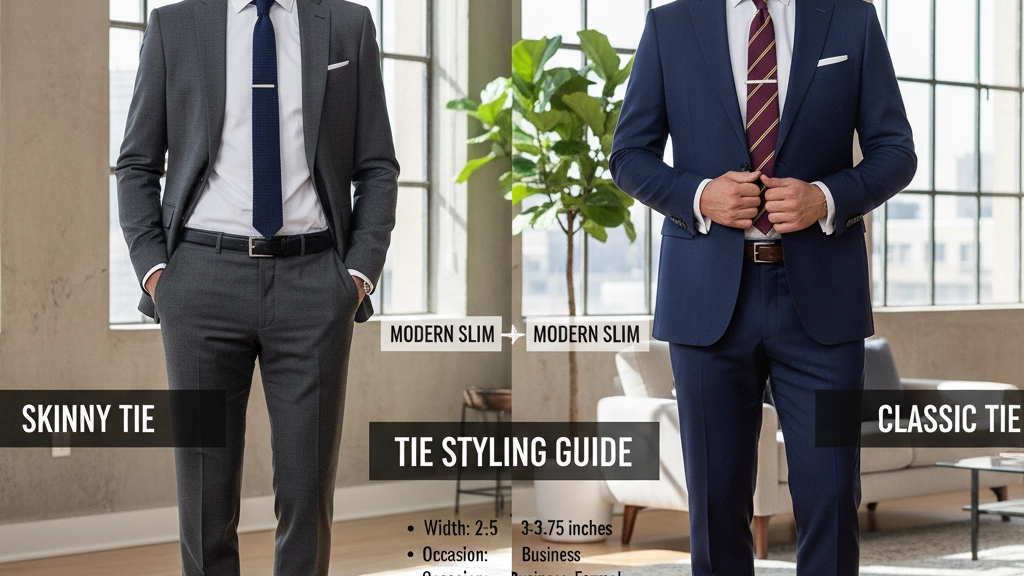Tie Widths Explained: Skinny vs. Classic
Understanding tie width is your first step to mastering your style. Here’s the breakdown in inches and centimeters:
| Tie Style | Width Range (inches) | Width Range (cm) | Description |
|---|---|---|---|
| Classic (Traditional/Full) | 3.25 – 3.75 | 8 – 9.5 | The timeless, business-ready width |
| Modern Classic | 3 – 3.25 | 7.5 – 8 | Sleeker update on the classic |
| Slim / Mid-width | 2.75 – 3 | 7 – 7.5 | The in-between for versatile styling |
| Skinny | 1.5 – 2.5 | 4 – 6.5 | Sharp, trendy, and fashion-forward |
Visualize it like this: Imagine laying these ties side-by-side—classic ties command attention with their wider silhouette, perfect for traditional suits and formal occasions. Skinny ties offer a slim, sharp look that pairs best with modern, fitted cuts.
Keeping these dimensions in mind makes choosing the right tie width straightforward. Choose your tie width like you choose your suit fit—it should complement you, not fight you.
A Brief History – Why Both Still Exist in 2025

Classic ties have their roots in the 1920s through the 1980s, when wider, traditional tie widths were the norm in business dress. This style made a strong comeback alongside the modern tailored suiting trend, which favors timeless, polished looks that never go out of style.
Skinny ties, on the other hand, first gained popularity in the 1950s and ’60s, symbolizing a sleek, youthful vibe. Their real explosion came with the rise of slim-fit suits in the 2000s and 2010s, appealing to those wanting a sharper, more fashion-forward edge.
Today, both styles remain relevant. The classic tie is back stronger than ever, a go-to for formal and business settings. Skinny ties have settled in as a deliberate choice for those in creative fields or anyone looking to make a modern statement without sacrificing sophistication. This balance keeps both tie widths alive and well in 2025. For more insights, combining classic ties with minimalist styling ideas can elevate your outfit, much like the comeback of vintage jewelry styles adds timeless charm.
Face Shape & Body Type Guide: The #1 Decision Factor

Choosing the right tie width starts with your face shape and body type. If you have a narrow or slim face paired with a lean build, a skinny or slim tie between 2 and 2.75 inches usually looks best. It keeps your proportions balanced without overwhelming your frame.
On the other hand, if you have broad shoulders, a wider face, or an athletic to average build, a classic tie in the 3 to 3.5-inch range tends to suit you better. The extra width complements your structure and looks natural.
If you’re tall and very thin, you’re lucky—you can pull off either style comfortably. But if you are on the shorter or stockier side, avoid extremely skinny ties, as they can make your frame appear bulky or mismatched.
Think of Ryan Gosling as a prime example of pulling off slimmer ties with his lean frame, while Chris Hemsworth’s broader shoulders call for the classic tie width.
This tie width guide helps you avoid the common mistake of picking a trendy size that doesn’t fit your body type, ensuring you look sharp and well-proportioned every time.
Suit & Shirt Proportions – The Golden Rule

Matching your tie width to your suit and shirt helps you pull off a sharp, balanced look. The key is harmony between lapel width and tie size:
-
Wide lapels + classic tie
If your jacket has wide lapels, go for a classic tie (3–3.5 inches). It keeps everything proportional and visually pleasing.
-
Narrow lapels + skinny/slim tie
Slim or skinny ties (1.5–2.75 inches) suit jackets with narrower lapels perfectly. This combo works especially well with modern slim-fit or skinny suits, which almost demand a slimmer tie to avoid overwhelming the look.
-
Shirt collar styles matter too
Spread or cutaway collars pair best with classic, wider ties — they fill the space well and keep the proportions balanced. Meanwhile, pointed or narrow collars look great with skinny or slim ties, maintaining a clean, contemporary finish.
For detailed tips on tying the perfect knot for each tie style, check out this master 5 essential tie knots step-by-step guide to complete your outfit flawlessly.
Occasion & Dress Code Breakdown
When choosing between skinny vs. classic ties, your occasion and dress code matter a lot.
- Formal business, boardroom, or black-tie optional events: Stick with a classic tie. Its traditional width (3–3.5 inches) is polished and professional—almost never goes wrong in these settings.
- Creative industries, tech, or fashion-forward offices: Skinny or slim ties (1.5–2.75 inches) fit right in. They add a modern touch and pair perfectly with slim-fit suits or more casual tailored looks.
- Weddings: Tie width depends on your suit. Most grooms opt for versatile widths between 2.75 and 3.25 inches—right in the “perfect in-between” zone that balances tradition with style.
- Casual or smart-casual occasions: Skinny ties work well here, especially when you ditch the jacket or team them with cardigans for a laid-back, stylish feel.
Choosing the right tie width for the occasion ensures you look sharp without trying too hard, no matter your style or setting.
The Rise of the “Perfect In-Between” (2.75–3.1 inches)
In 2025, the tie width that’s stealing the spotlight is this “perfect in-between” range—about 2.75 to 3.1 inches. This hybrid width strikes a balance between the skinny and classic options, making it the go-to choice for most men. It’s slim enough to complement modern, tailored suits without feeling overly narrow, but still broad enough to maintain a timeless, versatile look.
Most brands now push this width because it works well across a variety of body types and suit styles, reducing the guesswork about what width to pick. For around 90% of men, it delivers that polished appearance whether you’re dressing for business, weddings, or smart-casual occasions.
This width also aligns well with current lapel and shirt trends, fitting smoothly with both slim and medium lapels, and pairing nicely with both spread and mildly pointed collars. If you’re wondering how to choose tie width without constantly swapping ties, this is the safest, most stylish bet.
If you want to understand how this versatility fits into an overall stylish look, check out accessory guides like the rise of sustainable and ethical fashion jewelry for insights on balancing classic and modern touches in your wardrobe.
Styling Tips for Each Tie Width
When it comes to skinny vs. classic ties, the way you knot them and choose patterns can make a big difference.
Knots for Skinny Ties:
Skinny ties work best with the Four-in-Hand knot – it’s slim, simple, and matches the tie’s narrow profile perfectly. Avoid bulky knots here; they’ll overpower the slim shape.
Knots for Classic Ties:
Classic ties (3–3.75 inches wide) can handle bigger knots. The Half-Windsor and Full Windsor are ideal—they create a fuller, balanced look that suits the wider tie and often wider shirt collars.
Pattern and Texture Tips:
- Bold patterns and textures really shine on classic-width ties. Larger widths give these styles room to make an impact without looking cramped.
- Skinny ties look best in solid colors, subtle patterns, or simple textures. Busy designs can look overwhelming on a narrow tie.
Matching knot style and pattern to your tie width helps keep your whole outfit balanced and sharp. For more on keeping your accessories in top shape, check out this simple guide to storing your necklaces and bracelets—it’s all about care and presentation.
Common Mistakes to Avoid
When choosing between skinny and classic ties, avoid these common pitfalls to keep your look sharp:
- Wearing a 2-inch tie with 4-inch lapels: This throws off the balance. Skinny ties pair best with narrow lapels, so avoid pairing super slim ties with wide lapels to maintain the right proportion.
- Pairing a 3.75-inch tie with a super-slim suit: A wide classic tie can overwhelm a slim-fit suit. Keep the tie width in harmony with the suit’s cut for a sleek, put-together look.
- Buying based only on trend, not body type: Don’t pick a tie just because it’s “in style.” The best tie width depends on your build and face shape. Choosing the wrong width can look off and feel uncomfortable.
Keeping these mistakes in check ensures your tie complements your outfit and body type perfectly—crucial for mastering the tie and lapel proportion rule. For more style tips, check out our guide on personalized jewelry trends that add unique finishing touches to your look.
Quick Decision Cheat Sheet: Find Your Tie Width Fast
Answer these 5 yes/no questions to get an instant recommendation on whether a skinny, classic, or in-between tie is right for you:
Do you have a slim or narrow face and build?
– Yes → Go skinny/slim (1.5–2.75 inches)
– No → Next question
Are your shoulders broad or is your build athletic/average?
– Yes → Classic tie (3–3.5 inches) works best
– No → Next question
Do you usually wear slim-fit or skinny suits?
– Yes → Skinny or mid-width ties suit you well
– No → Classic or mid-width ties are safer
Do you prefer sharp, formal looks for business or special events?
– Yes → Classic ties never disappoint in formal settings
– No → Skinny or in-between widths can add flair
Do most of your shirts feature narrow collars, or do you favor casual outfits?
– Narrow collar or casual look → Skinny or slim ties work great
– Spread collars or classic business shirts → Classic ties fit best
Result at a glance:
- Mostly “Yes” to 1, 3, or 5 → Skinny or slim ties
- Mostly “Yes” to 2 or 4 → Classic ties
- Mixed answers → Choose the versatile in-between width (2.75–3.1 inches)
This simple guide makes choosing your tie width quick and effective—no more guessing or following fleeting trends. For more style pointers, check out our tips on layering accessories for a complete polished look.
Final Verdict: Which One Should You Own?
When it comes down to choosing between skinny vs. classic ties, here’s a simple rule of thumb: every man should own at least one classic tie between 3 and 3.25 inches wide. This width works with most body types, suits, and occasions, making it a timeless, reliable choice.
If your style leans towards slim-fit suits or you work in a creative environment where fashion-forward looks rule, adding a skinny tie around 2 to 2.5 inches can give your outfit a sharper, modern edge. Just remember, skinny ties are more of a deliberate style move than an everyday default.
For anyone looking for the ultimate versatile option, the 2.75 to 3.1-inch tie hits the sweet spot — the perfect in-between that complements most builds, suits, and dress codes without looking out of place.
Keep in mind, investing in the right tie width not only enhances your appearance but also respects the tie and lapel proportion rule, which plays a big role in how polished your overall look feels. To complete your outfit, consider pairing your tie choice with accessories that fit your personal style, such as those featured in the guide on must-have accessories for your summer wardrobe. This helps create a cohesive, stylish look no matter the occasion.


